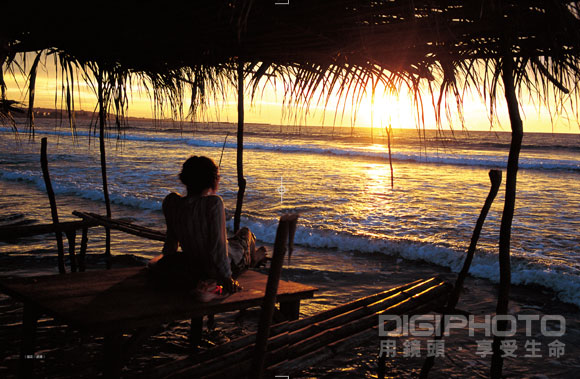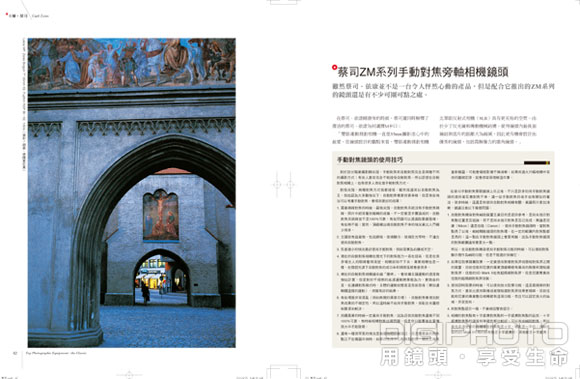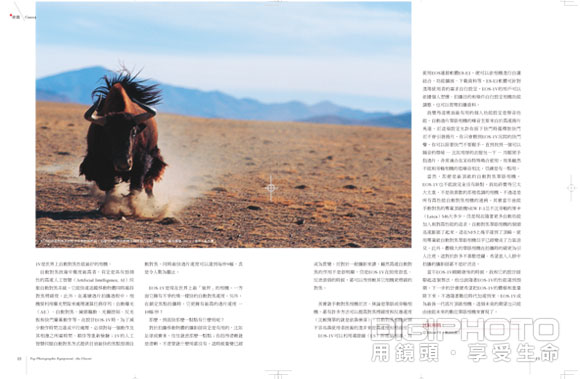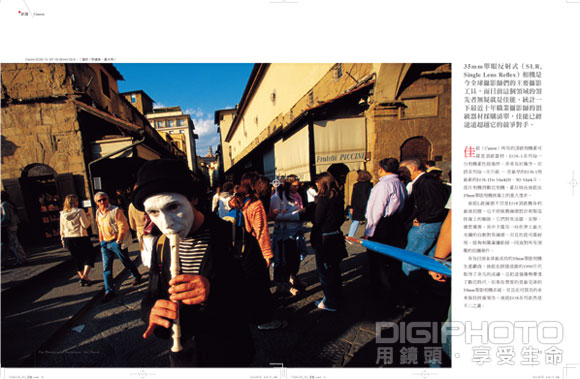頂級攝影器材(傳統篇)
 器材的發展,推動著攝影術的進步---頂級攝影器材的價值大多不在於器材本身,而在於它可以更輕鬆地記錄更優質的影像。和其它藝術形式相比,攝影是一項更著重於記錄時間的藝術,如果你希望幾十年後看到現在的照片還會被影像中細膩的情感和熠熠生輝的細節打動,你就應該多瞭解頂級攝影器材。
器材的發展,推動著攝影術的進步---頂級攝影器材的價值大多不在於器材本身,而在於它可以更輕鬆地記錄更優質的影像。和其它藝術形式相比,攝影是一項更著重於記錄時間的藝術,如果你希望幾十年後看到現在的照片還會被影像中細膩的情感和熠熠生輝的細節打動,你就應該多瞭解頂級攝影器材。內容簡介
給追求極致相機工藝的你,最全面的頂級攝影器材深入剖析!
什麼是頂級攝影器材?
它不見得是市面上價格最昂貴的器材,卻是最能發揮自身價值,幫助你更輕鬆地拍出更優質的影像。它不是拍出好照片的保證,卻有可能把一張好照片變成傳世之作。
它不見得是市面上價格最昂貴的器材,卻是最能發揮自身價值,幫助你更輕鬆地拍出更優質的影像。它不是拍出好照片的保證,卻有可能把一張好照片變成傳世之作。
誰需要頂級攝影器材?
並不是每個人都需要頂級攝影器材,也不是所有頂級攝影器材都適合每一個人;但是如果你明白自己的攝影方向,使用頂級攝影器材卻能幫助你更上層樓。
並不是每個人都需要頂級攝影器材,也不是所有頂級攝影器材都適合每一個人;但是如果你明白自己的攝影方向,使用頂級攝影器材卻能幫助你更上層樓。
本書作者趙嘉是聯合國兒童基金會(UNICEF)攝影顧問,亦是《美麗佳人》與《國家地理旅遊雜誌》簽約攝影師,其作品遍及人文、旅遊、時尚等多個領域,足跡更遍及西藏、尼泊爾等極為艱苦的拍攝環境。
本書列為頂級攝影器材的相機遍及35mm、中片幅相機、輕便相機與袖珍相機等領域,其獲選乃基於下列理由:
⊙ 專業頂級相機:某一類型相機中水準最高者,或是該類型相機的代表;
⊙ 具有不可替代之獨特性,或在某一專業領域備獲肯定;
⊙ 1972年後仍在生產的機型;
⊙ 主要用於實際拍攝的機型,收藏用的純粹紀念款式不在討論之列。
⊙ 專業頂級相機:某一類型相機中水準最高者,或是該類型相機的代表;
⊙ 具有不可替代之獨特性,或在某一專業領域備獲肯定;
⊙ 1972年後仍在生產的機型;
⊙ 主要用於實際拍攝的機型,收藏用的純粹紀念款式不在討論之列。
本書自2006年初版以來,便成為大陸地區最暢銷的攝影叢書之一,年年修訂再版仍獲得市場熱烈支持。由於本書內容日益增加,本次繁體中文版遂在作者授意之下,修訂部分內容,並拆分成《傳統篇》與《數位篇》(2010年11月初出版)兩本,以惠閱讀需求不同之讀者。








作者簡介
關於作者|趙嘉
1972年出生於北京,現從事攝影及傳媒相關工作。
作為攝影師和攝影指導,他長於紀實與報導攝影專題,與多家人文地 理、時尚類雜誌及相關機構合作,也喜歡嘗試不同攝影領域;作為攝影器材和技術領域的專家,他撰寫的文章也見諸於多家攝影刊物,同時為媒體、影視製作公司及 學校進行攝影和特技攝影方面的培訓。現為聯合國兒童基金會(UNICEF)攝影顧問、《美麗佳人》(Marie Claire)及《國家地理旅遊雜誌》(National Geographic Traveler)雜誌簽約攝影師、中國攝影家協會會員,亦是中國大陸最暢銷的攝影圖書作者,出版書目遍及諸多領域。
1972年出生於北京,現從事攝影及傳媒相關工作。
作為攝影師和攝影指導,他長於紀實與報導攝影專題,與多家人文地 理、時尚類雜誌及相關機構合作,也喜歡嘗試不同攝影領域;作為攝影器材和技術領域的專家,他撰寫的文章也見諸於多家攝影刊物,同時為媒體、影視製作公司及 學校進行攝影和特技攝影方面的培訓。現為聯合國兒童基金會(UNICEF)攝影顧問、《美麗佳人》(Marie Claire)及《國家地理旅遊雜誌》(National Geographic Traveler)雜誌簽約攝影師、中國攝影家協會會員,亦是中國大陸最暢銷的攝影圖書作者,出版書目遍及諸多領域。
趙嘉是活躍的人道主義者,以其對高原環境的熟悉與瞭解,時常投身人道救援活動,近年來四川、青海等地震災無役不與;他也從個人生活中做起,為環境保護略盡棉薄心力。
目錄
002 推薦序
007 序
009 佳能/Canon
‧自動對焦技術與EOS系列底片機身的發展
‧Canon EOS-1V
‧Canon EOS-3
‧EOS底片相機使用注意事項
‧固定式半透明反光鏡相機
‧L級鏡頭
‧L級鏡頭使用注意事項
【BOX】眼控對焦技術
029 卡爾.蔡司/CarlZeiss
‧蔡司簡史
‧Hologon
‧Biogon
‧Planar
‧Sonnar
‧Distagon
‧Tessar
‧蔡司鏡頭與不同相機系統的配合
‧Zeiss Ikon 蔡司.依康旁軸相機
‧蔡司ZM系列手動對焦旁軸相機鏡頭
‧蔡司ZE/ZF/ZK/ZS單眼系列手動對焦鏡頭
【BOX】卡爾蔡司相機攝影鏡頭發展里程碑
【BOX】T*的含意
【BOX】手動對焦鏡頭的使用技巧
【BOX】蔡司、日本代工和「血統論」
【BOX】蔡司與其它廠商的合作事件簿
047 康太時/Contax
‧認識康太時
‧C/Y系列機身
‧ContaxAX
‧ContaxRTS
‧C/Y卡口鏡頭
‧C/Y卡口相機及鏡頭使用注意事項
‧康太時G系列
‧G系列鏡頭
‧Contax 645
‧康太時N系列
‧Vario-SonnarT*17-35mmf/2.8
‧PlanarT*85mmf/1.4
‧康太時的袖珍相機
‧Contax T
‧Contax T2
‧Contax T3
‧康太時TVS系列
‧Contax TVSIII
‧康太時135鏡頭規格
【BOX】AE型&MM型C/Y卡口鏡頭的差異
【BOX】德國鏡頭和日本鏡頭的差別
【BOX】選擇G1或G2?
【BOX】如何利用袖珍相機的UV鏡和遮光罩增強其防水性能
091 富士/Fujifilm
‧富士中片幅相機
‧Fujifilm GA645Zi
‧Fujifilm GX617
103 吉爾得/Gilde
‧吉爾得相機性能介紹
‧吉爾得相機的技術特點
109 哈蘇/Hasselblad
‧哈蘇V系列
‧哈蘇500系列
‧Hasselblad 501CM
‧Hasselblad 503CW
‧哈蘇200系列
‧Hasselblad 205FCC
‧哈蘇SWC系列
‧Hasselblad 905SWC
‧哈蘇V系列使用注意事項
‧V系列鏡頭的選擇
‧哈蘇Xpan系列
‧Xpan鏡頭
【BOX】V系列鏡頭的命名方式
【BOX】哈蘇的增距鏡
137 騎士/Horseman
‧Horseman SW617Pro
141 柯尼卡美能達/Konica-Minolta
‧Konica Hexar
‧Konica Hexar使用注意事項
‧Konica HexarRF
‧Konica HexarRF搭配鏡頭
151 徠卡/Leica
‧M系列—徠卡的靈魂
‧徠卡M系列機身的歷史
‧Leica M3
‧Leica M2/M1
‧Leica M4
‧Leica M5
‧Leica CL
‧Leica M4-2
‧Leica M4-P
‧Leica M6
‧Leica M6 TTL
‧Leica M7
‧Leica MP
‧徠卡M機身的選擇
‧“alacarte”:量身訂做版本
‧底片時代的徠卡M系列鏡頭
‧超廣角與廣角鏡頭
‧28mm鏡頭
‧35mm鏡頭
‧標準鏡頭
‧中焦距鏡頭
‧Tri-Elmar-M 28-35-50mm f/4 ASPH
‧徠卡M系列使用注意事項
‧徠卡的袖珍相機
‧Leica Minilux
‧LeicaCM
‧Minilux Zoom & CM Zoom
‧徠卡M系列鏡頭規格比較表
【BOX】特殊版本的M6與M6TTL
【BOX】測距、基線長度與取景倍率
【BOX】徠卡M鏡頭的命名原則
【BOX】其它廠商生產的徠卡M卡口鏡頭
189 林可夫/Linhof
‧Technorama系列相機
‧林可夫寬片幅相機使用注意事項
197瑪米亞/Mamiya
‧Mamiya 6
‧Mamiya 7
‧瑪米亞使用注意事項
【BOX】其它同類相機的比較
【BOX】Mamiya6 & Mamiya7
205 美樂時/Minox
‧美樂時35系列
【BOX】後期生產的美樂時相機規格表
【BOX】如何提升估焦能力
【BOX】類似相機:巴爾達(Balda)
211 尼康/Nikon
‧尼康F系列機身
‧Nikon F
‧Nikon F2
‧Nikon F3
‧Nikon F4
‧Nikon F5
‧Nikon F6
‧尼康FM系列
‧Nikon FM
‧Nikon FM2
‧Nikon FM3A
‧Nikkor鏡頭
‧Nikkor鏡頭的黃金時代
‧Nikkor鏡頭的選擇
‧尼康的水下相機—Nikonos
【BOX】Nikon F3的不同版本
231 賓得士/Pentax
‧35mm專業頂級機 — Pentax LX
‧FA 43mm f/1.9 LE
‧Pentax 645N
‧Pentax 645N的鏡頭
‧賓得士67系統
‧Pentax 67II的鏡頭
‧Pentax 645N v.s. Pentax 67II
245 派寶/Plaubel
‧Plaubel Makina 67
‧Plaubel 69W Proshift
‧派寶相機使用注意事項
253 理光/Ricoh
‧理光GR1系列
‧Ricoh GR21
‧理光GR系列使用注意事項
259 祿來/Rollei
‧祿來6008系列
‧Rollei 6008 I/AF
‧祿來6008鏡頭系列
‧祿來6008系列鏡頭規格表
‧祿來雙眼反射式相機
‧Rolleiflex 2.8 GX/FX
‧Rolleiflex 4.0 FW
‧祿來35系列
‧祿來QZ35系列
【BOX】PQ&PQS鏡頭的差異
【BOX】祿來35的版本
【BOX】40mm鏡頭的景深表
【BOX】祿來35系列生產年表
281福倫達/Voigtlander
‧SuperWide-Heliar Aspherical 15mm f/4.5
285【附錄】關於頂級攝影器材的問答
007 序
009 佳能/Canon
‧自動對焦技術與EOS系列底片機身的發展
‧Canon EOS-1V
‧Canon EOS-3
‧EOS底片相機使用注意事項
‧固定式半透明反光鏡相機
‧L級鏡頭
‧L級鏡頭使用注意事項
【BOX】眼控對焦技術
029 卡爾.蔡司/CarlZeiss
‧蔡司簡史
‧Hologon
‧Biogon
‧Planar
‧Sonnar
‧Distagon
‧Tessar
‧蔡司鏡頭與不同相機系統的配合
‧Zeiss Ikon 蔡司.依康旁軸相機
‧蔡司ZM系列手動對焦旁軸相機鏡頭
‧蔡司ZE/ZF/ZK/ZS單眼系列手動對焦鏡頭
【BOX】卡爾蔡司相機攝影鏡頭發展里程碑
【BOX】T*的含意
【BOX】手動對焦鏡頭的使用技巧
【BOX】蔡司、日本代工和「血統論」
【BOX】蔡司與其它廠商的合作事件簿
047 康太時/Contax
‧認識康太時
‧C/Y系列機身
‧ContaxAX
‧ContaxRTS
‧C/Y卡口鏡頭
‧C/Y卡口相機及鏡頭使用注意事項
‧康太時G系列
‧G系列鏡頭
‧Contax 645
‧康太時N系列
‧Vario-SonnarT*17-35mmf/2.8
‧PlanarT*85mmf/1.4
‧康太時的袖珍相機
‧Contax T
‧Contax T2
‧Contax T3
‧康太時TVS系列
‧Contax TVSIII
‧康太時135鏡頭規格
【BOX】AE型&MM型C/Y卡口鏡頭的差異
【BOX】德國鏡頭和日本鏡頭的差別
【BOX】選擇G1或G2?
【BOX】如何利用袖珍相機的UV鏡和遮光罩增強其防水性能
091 富士/Fujifilm
‧富士中片幅相機
‧Fujifilm GA645Zi
‧Fujifilm GX617
103 吉爾得/Gilde
‧吉爾得相機性能介紹
‧吉爾得相機的技術特點
109 哈蘇/Hasselblad
‧哈蘇V系列
‧哈蘇500系列
‧Hasselblad 501CM
‧Hasselblad 503CW
‧哈蘇200系列
‧Hasselblad 205FCC
‧哈蘇SWC系列
‧Hasselblad 905SWC
‧哈蘇V系列使用注意事項
‧V系列鏡頭的選擇
‧哈蘇Xpan系列
‧Xpan鏡頭
【BOX】V系列鏡頭的命名方式
【BOX】哈蘇的增距鏡
137 騎士/Horseman
‧Horseman SW617Pro
141 柯尼卡美能達/Konica-Minolta
‧Konica Hexar
‧Konica Hexar使用注意事項
‧Konica HexarRF
‧Konica HexarRF搭配鏡頭
151 徠卡/Leica
‧M系列—徠卡的靈魂
‧徠卡M系列機身的歷史
‧Leica M3
‧Leica M2/M1
‧Leica M4
‧Leica M5
‧Leica CL
‧Leica M4-2
‧Leica M4-P
‧Leica M6
‧Leica M6 TTL
‧Leica M7
‧Leica MP
‧徠卡M機身的選擇
‧“alacarte”:量身訂做版本
‧底片時代的徠卡M系列鏡頭
‧超廣角與廣角鏡頭
‧28mm鏡頭
‧35mm鏡頭
‧標準鏡頭
‧中焦距鏡頭
‧Tri-Elmar-M 28-35-50mm f/4 ASPH
‧徠卡M系列使用注意事項
‧徠卡的袖珍相機
‧Leica Minilux
‧LeicaCM
‧Minilux Zoom & CM Zoom
‧徠卡M系列鏡頭規格比較表
【BOX】特殊版本的M6與M6TTL
【BOX】測距、基線長度與取景倍率
【BOX】徠卡M鏡頭的命名原則
【BOX】其它廠商生產的徠卡M卡口鏡頭
189 林可夫/Linhof
‧Technorama系列相機
‧林可夫寬片幅相機使用注意事項
197瑪米亞/Mamiya
‧Mamiya 6
‧Mamiya 7
‧瑪米亞使用注意事項
【BOX】其它同類相機的比較
【BOX】Mamiya6 & Mamiya7
205 美樂時/Minox
‧美樂時35系列
【BOX】後期生產的美樂時相機規格表
【BOX】如何提升估焦能力
【BOX】類似相機:巴爾達(Balda)
211 尼康/Nikon
‧尼康F系列機身
‧Nikon F
‧Nikon F2
‧Nikon F3
‧Nikon F4
‧Nikon F5
‧Nikon F6
‧尼康FM系列
‧Nikon FM
‧Nikon FM2
‧Nikon FM3A
‧Nikkor鏡頭
‧Nikkor鏡頭的黃金時代
‧Nikkor鏡頭的選擇
‧尼康的水下相機—Nikonos
【BOX】Nikon F3的不同版本
231 賓得士/Pentax
‧35mm專業頂級機 — Pentax LX
‧FA 43mm f/1.9 LE
‧Pentax 645N
‧Pentax 645N的鏡頭
‧賓得士67系統
‧Pentax 67II的鏡頭
‧Pentax 645N v.s. Pentax 67II
245 派寶/Plaubel
‧Plaubel Makina 67
‧Plaubel 69W Proshift
‧派寶相機使用注意事項
253 理光/Ricoh
‧理光GR1系列
‧Ricoh GR21
‧理光GR系列使用注意事項
259 祿來/Rollei
‧祿來6008系列
‧Rollei 6008 I/AF
‧祿來6008鏡頭系列
‧祿來6008系列鏡頭規格表
‧祿來雙眼反射式相機
‧Rolleiflex 2.8 GX/FX
‧Rolleiflex 4.0 FW
‧祿來35系列
‧祿來QZ35系列
【BOX】PQ&PQS鏡頭的差異
【BOX】祿來35的版本
【BOX】40mm鏡頭的景深表
【BOX】祿來35系列生產年表
281福倫達/Voigtlander
‧SuperWide-Heliar Aspherical 15mm f/4.5
285【附錄】關於頂級攝影器材的問答
推薦序
哈蘇首席執行官(Hasselblad CEO)/克里斯丁.普桑(Christian Poulsen)
在今日,攝影較以往更被視為藝術創作。有鑑於攝影器材的複雜性與日俱增,世界各地攝影發燒友們的創造靈感也相應地無限增長。
無論業餘還是全職,絕大多數攝影師都夢想著他們可以拍出完美的照片,捕捉到那個能夠顯示個人才能的瞬間。對很多攝影師來說這仍然是個夢想,但是對於那些無法盡可能配備優良攝影裝備的人來說,也許就成了最大的遺憾。在哈蘇,我們樂於為此籌謀,只要攝影師得到這一機會,我們至少能提供接近最好的相機。
今年是哈蘇創始人維克多.哈蘇(Victor Hasselblad)的百年誕辰。他對攝影和技術的熱情意味著他可以徹底瞭解其他攝影師的需求,並藉由不斷改進技術來努力滿足這一需要。維克多將一生熱情注入他所選擇的這一門藝術,為幾代攝影師提供了利器,供其捕捉史上最觸動人心的照片。
對攝影的熱愛和瞭解,勇於設立產品生產最高標準的膽識,以及投資於攝影產業的能力和決心,代表了哈蘇六十年以來始終如一的核心價值。
今日,我們依舊秉承當初職責,致力於一個簡單任務:生產人類所知最好的攝影器材。達到這一目標才能使我們無愧於我們的品牌承諾 — 協助攝影師發揮他們最大的潛能。
曾經有人認為錄影將會替代靜態的攝影,但是這並沒有發生;隨著數位技術的發展,這更不太可能在近期發生。對於我自己來說,我更願意相信文字、靜態圖片和讀者的想像力的總和,將優於錄影的被動消費。
同樣,也有人曾認為寫作的藝術和書籍會消亡,但事實證明現今全球書籍銷售額比史上任何時期都要高。閱畢本書,您就會對其中原由了然於心。本人希望,閱讀該書能帶給您和我們一樣多的愉悅感受。
因此,我們很高興能與《頂級攝影器材》合作,該書傾注了作者、攝影師趙嘉先生和出版社的大量投入。我們祝賀他們出版了一部無論在資訊量或視覺衝擊力方面都屬上乘的優質作品;我們希望該書能夠激發讀者繼續發掘他們自身的攝影潛能。
在今日,攝影較以往更被視為藝術創作。有鑑於攝影器材的複雜性與日俱增,世界各地攝影發燒友們的創造靈感也相應地無限增長。
無論業餘還是全職,絕大多數攝影師都夢想著他們可以拍出完美的照片,捕捉到那個能夠顯示個人才能的瞬間。對很多攝影師來說這仍然是個夢想,但是對於那些無法盡可能配備優良攝影裝備的人來說,也許就成了最大的遺憾。在哈蘇,我們樂於為此籌謀,只要攝影師得到這一機會,我們至少能提供接近最好的相機。
今年是哈蘇創始人維克多.哈蘇(Victor Hasselblad)的百年誕辰。他對攝影和技術的熱情意味著他可以徹底瞭解其他攝影師的需求,並藉由不斷改進技術來努力滿足這一需要。維克多將一生熱情注入他所選擇的這一門藝術,為幾代攝影師提供了利器,供其捕捉史上最觸動人心的照片。
對攝影的熱愛和瞭解,勇於設立產品生產最高標準的膽識,以及投資於攝影產業的能力和決心,代表了哈蘇六十年以來始終如一的核心價值。
今日,我們依舊秉承當初職責,致力於一個簡單任務:生產人類所知最好的攝影器材。達到這一目標才能使我們無愧於我們的品牌承諾 — 協助攝影師發揮他們最大的潛能。
曾經有人認為錄影將會替代靜態的攝影,但是這並沒有發生;隨著數位技術的發展,這更不太可能在近期發生。對於我自己來說,我更願意相信文字、靜態圖片和讀者的想像力的總和,將優於錄影的被動消費。
同樣,也有人曾認為寫作的藝術和書籍會消亡,但事實證明現今全球書籍銷售額比史上任何時期都要高。閱畢本書,您就會對其中原由了然於心。本人希望,閱讀該書能帶給您和我們一樣多的愉悅感受。
因此,我們很高興能與《頂級攝影器材》合作,該書傾注了作者、攝影師趙嘉先生和出版社的大量投入。我們祝賀他們出版了一部無論在資訊量或視覺衝擊力方面都屬上乘的優質作品;我們希望該書能夠激發讀者繼續發掘他們自身的攝影潛能。










